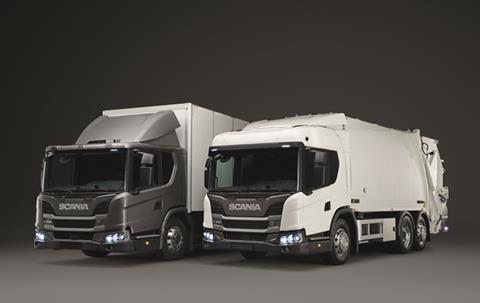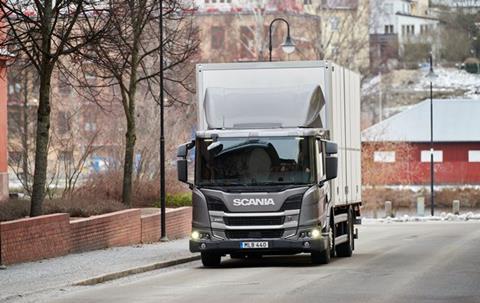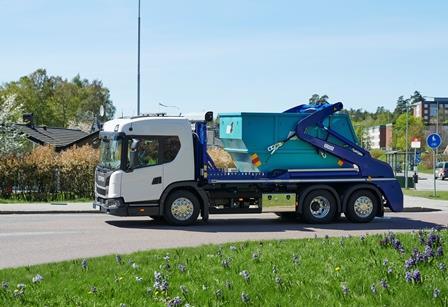
Scania has completed its Next Generation line-up with the launch of the low entry L-series cab, designed for urban operations where direct vision is essential.
The launch of the Scania L-series low-entry cab completed the line up of Next Generation trucks and, together with the new P-series and G-series introduced last year, rounds out the Swedish manufacturer’s urban offering.

The L-series is designed for two specific purposes – to ease driver access and to provide a better direct view of vulnerable road users.
“The L-series is an excellent example of Scania’s approach to customised solutions,” said Henrik Eng, product director, urban at Scania Trucks. “The L-series has been designed specifically to meet the kind of challenges that drivers in applications operating mainly in the urban environment have to contend with. The L-series really comes into its own in heavy traffic, where many different road users have to interact with one another.”
L-series cabs are available with three different roof heights, one or two access steps and a ‘kneeling’ option where the front air suspension automatically lowers when the handbrake is activated. This brings the bottom step to just 150mm above the ground on both sides of the cab. Cross-cab access is also excellent.
The L-series is powered by Scania’s updated 9-litre engine, which is available in three different power ratings for diesel and two ratings for natural gas (both CNG and LNG tanks are available). All engines can be combined with Scania Opticruise or with an Allison automatic gearbox. Typical axle configurations for urban applications are 4x2 or 6x2*4 using Scania’s electrically-steered tag axle.
“Offering excellent ergonomics for anyone who regularly climbs in and out of the vehicle, while making it easier for the driver to interact with their surroundings, is the right tune to play in the city,” said Eng. “If you also equip the truck with a Scania City Safe Window in the passenger door and a camera system, this enhances safety significantly.”
The Scania City Safe Window can also be ordered for the passenger door of all P-series cabs.

According to Scania GB, the bulk of UK L-series will go into the waste sector. “I’m confident that the L-series will really find its place here,” said Andrew Jamieson, Scania’s UK sales director of truck, bus, coach and engines. “It is very Scania-like in terms of the cab, and hence driver appeal. Other advantages are parts availability and repairs, along with the 5-Star Direct Vision Standard rating, great access, and great visibility.” He anticipates selling 600 into the waste sector over the next two years.
Tip-ex
Jamieson expects it to prove popular in construction, and Scania will be showing a tipper bodied tridem version at the Tip-ex Show in Harrogate on May 31 to June 2. He says: The L-cab with City Safe Window achieves a 5-Star rating, and hence I’m sure there will be some interest in the south east of England. There is a balance here though as the typical P-cab specification with City Window will achieve the 3-Star rating required through to 2024, and hence it will be those customers that want to go beyond the minimum standard that will opt for L-cab in these applications.” He anticipates sales to be “in the hundreds” for the first couple of years.
The new urban friendly L-series will not initially be available with Scania's new lightweight 7-litre engine. The 7-litre engine can be specified in the new P-series which Scania expects to account for half its sales volume in the urban sector.
The Next Generation P-series combines its traditional low-mounted format with larger windows, thinner A-pillars and a lower vision line from the reshaped dashboard to give improved visibility. They are ideal for urban and regional distribution, yet tough enough for construction and other off-road applications.
Three internal cab lengths are available from 1,400mm day cab to a 2,000mm sleeper, with low, normal and Highline roof heights. The P-series is available across the full range of rigid, tractor, construction and XT models for applications as diverse as fire and rescue, waste handling and recycling, airport support and urban or regional distribution. Entrance to the cab is low, with convenient handles that make it easy to climb in and out, though the driver sits high and has a good view of the traffic ahead.
On the road
Commercial Motor editor and International Truck of the Year jury member Will Shiers had a first drive in a typical example of the new L-series, an L 360 6x2, fitted with skip-loader bodywork.
Access couldn’t be easier, especially in one-step guise. With the air suspension in the kneeling position, the wide step is just 438mm from the ground so that you step rather than climb into the truck. With the two-step option, the bottom step is just 150mm above the ground, but it isn’t quite as easy to enter as the one-step version.
From the driver’s seat everything looks familiar, thanks to Scania’s modular build system. This same dashboard, complete with its soft-touch plastics and well thought out dials and switchgear, features in the entire new generation Scania range. It’s certainly a step above any other low-entry truck interior we have previously experienced.
Although the L-series cab is cavernous, there’s a large wasted area behind the front seats, mainly taken up by the obtrusive engine hump. There’s no space for a rest area, but there’s certainly more storage than any driver would ever need. There is an option of fitting two small extra seats, high up between the driver and passenger.
With the door closed and seatbelt on we fire up the 5-cylinder, 9-litre DC09 engine. There are three diesel ratings and ours is the top power 345hp version.

The cab swiftly rises 95mm to the driving position. It is possible to override this, and creep along at speeds of up to 30km/h in the kneeling position, which could prove handy for kerbside collections.
On the road we are immediately impressed by the view of our surroundings. We are already big fans of Scania’s new generation driving position, which moves the driver forwards and outwards, and when you’re sitting this low visibility really is superb.
As for the City Safe Window low in the passenger door, however, we’re not convinced. We have a Scania demo driver sitting in the passenger seat, and his knees totally block our view of the lower window.
Scania’s truck mirrors are great. They’re big - but do they really need to be this big on a truck designed specifically for operating in urban areas? On this occasion we’d prefer a smaller mirror, positioned closer to the cab, and less likely to bang pedestrians on the head.
Near perfect ride
Given its looks, we were expecting the L-series to behave like a dustcart on the road, but we couldn’t have been more mistaken. It wafts along serenely, with a near perfect ride and in almost silence. The lack of engine noise is surprising considering there are five cylinders working away in the cab just behind us.
It feels far more like a luxury coach than an HGV to drive – adding to this effect is the fact that we’re sitting ahead of the front axle.
With 345hp at our disposal, the half-laden 26-tonne skip wagon pulls effortlessly. The engine is matched perfectly to Scania’s vastly improved Opticruise gearbox, and there’s no need to reach for the manual override, even when tackling a steep hill.
Our previous experience with low-entry trucks is that they have been designed for low speed, and when you’re on the open road their design limitations become clear, with noticeably more noise, rattling and vibration. Not so for the L-series though, which seems equally happy cruising on the limiter as it is kerb-crawling.
At the end of the test we stop, and watch as the automatic handbrake applies itself. As soon as we take off our seatbelt the truck’s air suspension kneels, aiding our exit from the truck. It also lowers as soon as either door is opened. While it isn’t going to win any beauty pageants, what we have here is an incredibly competent and safe truck, built to make an urban truck driver’s life easier and safer. Surely that can only be a good thing.














